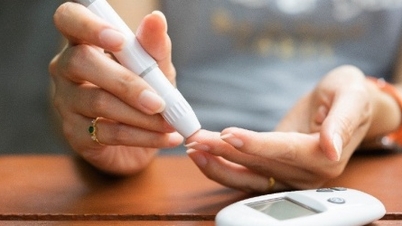At MEDLATEC Vinh Phuc General Clinic, the examination results showed that the child was overweight with a BMI of 25.7 (the normal index for Asians is under 23), with black thorns appearing on the nape of the neck, a typical sign of insulin resistance.
 |
| Illustration photo. |
The test showed that the fasting blood sugar was 7.26 mmol/L, HbA1c increased to 10.6% while the autoantibodies (Anti-GAD, ICA) were negative. Based on these results, the doctor diagnosed the child with type 2 diabetes, a disease that is considered to be an adult disease.
Patients are instructed to adjust their diet, increase exercise to lose weight and improve insulin resistance, combine blood sugar control medication, self-monitor blood sugar at home and have regular monthly check-ups.
According to Dr. Duong Thi Phuong Thuy, Deputy Director of MEDLATEC Vinh Phuc General Clinic, this is a clear warning bell about the situation of type 2 diabetes which is getting younger and younger, even creeping into school age. If in the past the disease was common in people over 40 years old, now many cases are detected in the age group of 14-15.
In Vietnam, the rate of diabetes has doubled in just one decade: from more than 4% of the population in 2012 to nearly 7.3% in 2020. By 2024, it is estimated that about 7 million Vietnamese people are living with this disease, of which more than 55% have complications, including 34% cardiovascular complications, 39.5% eye and nerve complications, and 24% kidney complications.
These figures show that the burden of disease is growing, not only affecting health but also reducing quality of life and increasing treatment costs.
Dr. Thuy said that type 2 diabetes in young people has a different pathogenesis compared to adults. During puberty, fluctuations in growth hormone and sex hormones make insulin resistance worse. At the same time, pancreatic beta cells in young people have poor compensatory ability, leading to a rapid decline in insulin secretion function.
In addition, genetic factors also play an important role. Children whose parents or relatives have diabetes will have a higher risk.
Combined with a modern sedentary lifestyle, eating a lot of fast food, sweets, sleeping late and studying stress, the risk of getting the disease increases. Many cases are diagnosed late because the symptoms are not clear, by the time the disease is discovered, it has caused complications such as damage to the eyes, kidneys, nerves or cardiovascular system.
For prevention and early detection, professional organizations such as the American Diabetes Association (ADA) and the Pediatric Endocrine Society (PES) recommend screening for diabetes in overweight or obese children (BMI above the 85th percentile or >25) with at least one additional risk factor such as having a relative with type 2 diabetes, signs of insulin resistance (acanthosis nigricans, polycystic ovaries, hypertension, dyslipidemia), birth weight over 4 kg or mother with a history of gestational diabetes.
Screening should begin at age 10 or when puberty begins (if earlier), repeated every 3 years if results are normal, and earlier if rapid weight gain or suspicious symptoms appear.
Dr. Thuy emphasized that early detection plays a decisive role in controlling the disease and preventing complications. When diagnosed early and treated promptly with a healthy diet, increased exercise, weight loss and adherence to medication, children can completely control their blood sugar well, avoiding serious damage later.
“Parents should not be subjective when they see their children urinating a lot, drinking a lot, losing weight or having unusually dark skin. Just a simple blood sugar test can help detect the disease early and protect their children's long-term health,” the doctor advised.
Type 2 diabetes is no longer considered an “adult disease”. The rapid resurgence of the disease reflects an unhealthy modern lifestyle of high-calorie diet, lack of exercise, dependence on electronic devices and lack of sleep.
However, the disease can be completely controlled if detected early, lifestyle adjustments and proper treatment. Regular screening, especially in children who are overweight or have risk factors, is the key to preventing complications and helping the younger generation maintain healthy, active and sustainable lives.
Source: https://baodautu.vn/nguoi-tre-mac-tieu-duong-gia-tang-bien-chung-ngay-cang-nguy-hiem-d425886.html


![[Photo] Ho Chi Minh City Youth Take Action for a Cleaner Environment](https://vphoto.vietnam.vn/thumb/1200x675/vietnam/resource/IMAGE/2025/11/04/1762233574890_550816358-1108586934787014-6430522970717297480-n-1-jpg.webp)

![[Photo] Panorama of the Patriotic Emulation Congress of Nhan Dan Newspaper for the period 2025-2030](https://vphoto.vietnam.vn/thumb/1200x675/vietnam/resource/IMAGE/2025/11/04/1762252775462_ndo_br_dhthiduayeuncbaond-6125-jpg.webp)

![[Photo] Ca Mau "struggling" to cope with the highest tide of the year, forecast to exceed alert level 3](https://vphoto.vietnam.vn/thumb/1200x675/vietnam/resource/IMAGE/2025/11/04/1762235371445_ndo_br_trieu-cuong-2-6486-jpg.webp)
![[Photo] The road connecting Dong Nai with Ho Chi Minh City is still unfinished after 5 years of construction.](https://vphoto.vietnam.vn/thumb/1200x675/vietnam/resource/IMAGE/2025/11/04/1762241675985_ndo_br_dji-20251104104418-0635-d-resize-1295-jpg.webp)



































































































Comment (0)